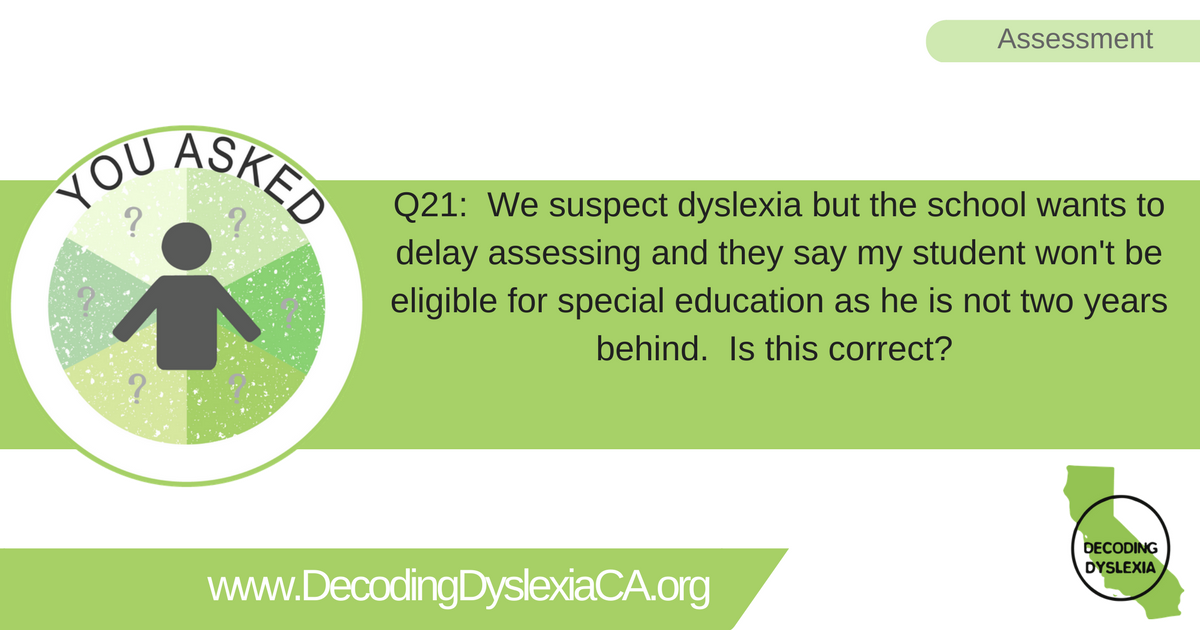Download a PDF version of this You Asked question and answer HERE.
Q21: We suspect dyslexia but the school wants to delay assessing and they say my student won’t be eligible for special education as he is not two years behind. Is this correct?
A: This is an unfortunate “urban legend” that has been repeated so many times that many school personnel believe it to be true. There is nothing in federal or California education law that states that a student must be two or more years behind in school to be found eligible for special education. If this were the case, it would be impossible for a student in kindergarten or first grade to ever be found eligible as they haven’t been in school for two years and it would be very difficult for even a second grader to be found eligible.
So where did this incorrect information originate?
As far as we can tell, it seems to be a result of confusion regarding use of the “severe discrepancy” model in identifying students as having a “Specific Learning Disability” for special education eligibility.
Under California law, there are three possible methods of determining whether a specific learning disability exists. One method allows for the use of a severe discrepancy model [5 CCR 3030(b)(10)(B)]. A severe discrepancy is defined as a difference between academic achievement and intellectual ability (“IQ”) of 1.5 standard deviations or more (adjusted by 1 standard error of measurement).
Let’s look at an example using a standard bell curve. Assume this student has an average IQ of 100 (standard score). In order to have a severe discrepancy, the student would have to receive a standard score in basic reading skills of 78 (or less) in order to have a standard deviation of 1.5 (or more). [This would also apply to oral expression, written expression, reading comprehension, mathematical calculation or mathematical reasoning scores].
In its most simplistic form, you can take your student’s IQ* standard score and subtract 22.5 points. The difference (IQ-22.5) is the standard score that would result in a 1.5 standard deviation score (adjusted by one standard error of measurement, not to exceed 4 points). You can then compare this number to the standard scores your student received on standardized academic achievement testing in order to determine whether there is a severe discrepancy or not. Any scores at or below this number would indicate the presence of a severe discrepancy.
In our example, a student would have to perform very poorly to have this much of a gap between achievement and IQ so perhaps this has been incorrectly interpreted to mean a “two-year gap”.
However, there are a few critical things to note:
- In California, the use of severe discrepancy may be considered but must not be required. [5 CCR 3030(b)(10)(B)], 34 CFR 300.307(a)(1)].
- There are two other methods for determining a Specific Learning Disability – student doesn’t make sufficient progress when using Response to Intervention (“RTI”) [5 CCR 3030(b)(10)(C)(1) and 5 CCR 3030(b)(10)(C)(2)(i) or the student exhibits a “pattern of strengths & weaknesses” [5 CCR 3030(b)(10)(C)(2)(ii)].
- In addition, even if standardized tests don’t reveal a severe discrepancy the IEP team may still find that one exists [refer to 5 CCR 3030(b)(10)(B)(2) or 5 CCR 3030(b)(10)(B)(3).
So, the next time you hear the “must be two years behind” statement, request in writing that the school district show you where this is reflected in the education code. [Spoiler Alert: It won’t be found.]
It can be helpful to ask the IEP team to provide documentation of the eligibility criteria they used in determining whether a Specific Learning Disability (SLD) exists and to walk you through their analysis. There are often “Specific Learning Disability Team Determination of Eligibility” forms that need to be completed and you should request a copy for your records. [IEP meetings discussing special education eligibility can be very complicated and may feel overwhelming to some parents. It is a good idea to audio record your student’s IEP meetings so you can listen again to any sections that were confusing. You just need to provide 24-hour advance notice in writing that you will be doing so.]
In addition, please refer to You Asked! question 23 as to why the use of severe discrepancy should be abandoned.
* – Please be advised that in California, IQ testing of African-American students is prohibited [refer to Larry P. v. Riles, 495 F. Supp. 926 (N.D. Cal 1979), 793 F. 2d 969 (9th Cir. 1984), 37 F. 3d 485 (9th Cir. 1994). Also, see article from CA Association of School Psychologists (CASP Today Spring 2013 – Larry P. Edition, pgs. 7, 17)].
For more YOU ASKED questions and answers click HERE.


